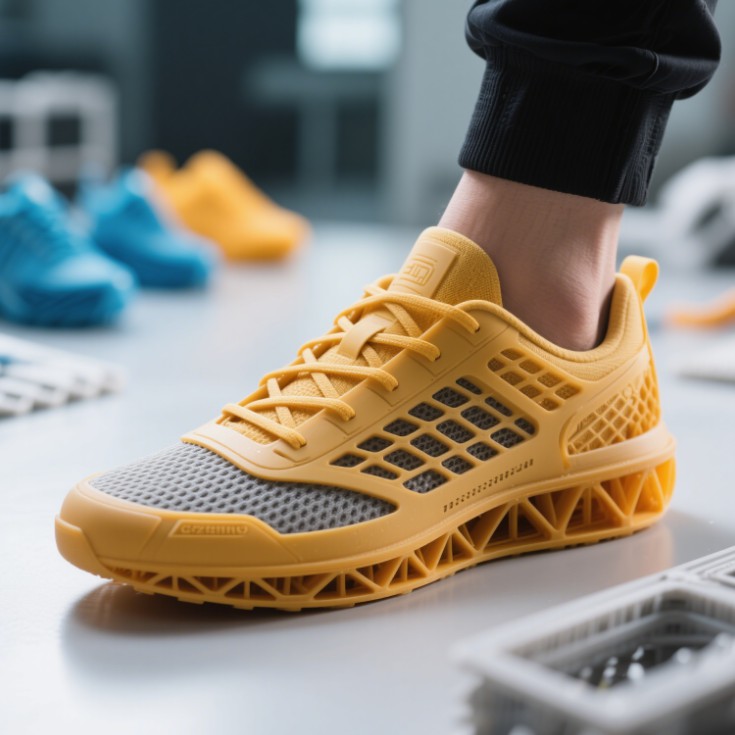The Future of Fit: How 3D-Printed Shoes Could Redefine Comfort
Jenna had always been a creature of habit, especially when it came to shoes. Every year, like clockwork, she’d buy a new pair of sneakers to replace the ones she wore down beyond recognition. And every year, she’d go through the same routine of squeezing her feet into something that was “close enough.” The size, the shape—it was never quite right. But what could she do? Shoes were shoes, and fitting was always a compromise.
It wasn’t until one rainy afternoon in a coffee shop that Jenna’s view on shoes—and comfort—would completely change. She was sitting with a friend, scrolling through a design magazine, when an ad for a new brand caught her eye. “Custom-Fit 3D-Printed Shoes—No More Compromise.” The words jumped out at her.
Curiosity piqued, Jenna dug deeper, learning that the company was using 3D printing to craft shoes specifically tailored to each person’s feet. Not just the length or width, but every contour and curve, every arch and the unique shape of your foot. She couldn’t help but think, Could it really be that simple? Could a shoe be made just for her, for the first time in her life?
She did some more digging. The concept wasn’t new. In fact, it had been in development for a while. Footwear companies had started experimenting with 3D printing, but the technology was still in its early stages—more of a “cool idea” than a true game-changer. But what caught Jenna’s attention was how this wasn’t just about making shoes for athletes or high-end customers. This was for everyone. For someone like her.
A few days later, Jenna found herself walking into a local 3D-printing studio, a curious mix of excitement and skepticism in her chest. The process was simpler than she thought—first, a quick scan of her feet. The technician swiped her feet with a handheld device, capturing every minute detail: the arches, the toe lengths, the heel angles. The data was uploaded into a computer, and within minutes, the shoe design was generated.
“No molds, no mass production,” the technician explained. “Every pair is made just for you. Your exact dimensions. It’s like having a tailor for your feet.”
Jenna was intrigued. She’d seen bespoke clothing before—luxury brands offering personalized fits—but shoes? This was a different kind of personalization. Shoes had always been a mass-produced item. If you wanted something truly unique, you went high-end and paid for custom leather. But this? This was different. It was affordable. It was practical. And the idea of walking around with shoes that were literally made for her felt like a breakthrough.

Two weeks later, Jenna picked up her pair. They didn’t look like anything extraordinary on the surface—black running shoes with a sleek design, low-key, not flashy. But the moment she slipped them on, she knew something was different. The fit was like nothing she had ever experienced. The arch support was perfect, the toe box just right. The shoes almost felt like an extension of her body. No pressure points, no rubbing. Just pure comfort, molded to her unique foot shape.
She took her first steps on the busy sidewalk and was immediately struck by the sensation. This is how shoes are supposed to feel, she thought. Like they were made to fit her every movement, every step. She wasn’t adjusting her feet to the shoe; the shoe was adjusting to her.
The more she wore them, the more she realized just how much of a revolution this could be. No more awkward sizing debates. No more suffering through shoes that were “close enough.” This was the future of footwear—personalized, accessible, and comfortable.
But as Jenna walked down the street, she thought about something else. This could change everything. She was no longer just a consumer of shoes; she was part of a larger movement. A future where mass production gave way to individualized, customized items. In a world that had always prioritized convenience over fit, the rise of 3D-printed shoes felt like a breakthrough not just in technology, but in culture.
As more people discovered the power of customized shoes, they could expect an explosion of creativity and possibility. No two pairs would be exactly alike. Athletes could order shoes that provided the exact support their foot structure demanded. People with special needs or foot conditions could finally find comfort without compromise. And maybe—just maybe—footwear companies would no longer treat sizing as an afterthought, but as a critical aspect of design.
Jenna couldn’t help but wonder if this was the beginning of a wider shift—a shift from one-size-fits-all to truly personalized products. As 3D printing technology evolved, it could change everything. Shoes, clothes, even accessories, all made to order, perfectly suited to the wearer. The future of fashion, made possible by technology and individual expression, was just beginning.
The dream of perfect-fit shoes, once thought of as a luxury, is slowly becoming a reality. 3D printing is not just a trend; it’s a doorway into a new era of customization. No more blisters. No more “close enough” fits. The shoes of the future are waiting—and they’re made just for you.
